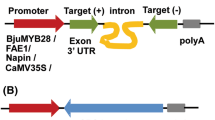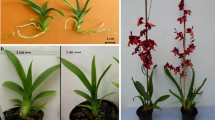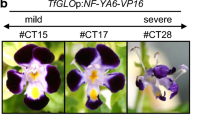Abstract
Oilseed rape (Brassica napus L.) genotypes with no or small petals are thought to have advantages in photosynthetic activity. The flowers of field-grown oilseed rape form a bright-yellow canopy that reflects and absorbs nearly 60% of the photosynthetically active radiation (PAR), causing a severe yield penalty. Reducing the size of the petals and/or removing the reflecting colour will improve the transmission of PAR to the leaves and is expected to increase the crop productivity. In this study the ‘hairpin’ RNA-mediated (hpRNA) gene silencing technology was implemented in Arabidopsis thaliana (L.) Heynh. and B. napus to silence B-type MADS-box floral organ identity genes in a second-whorl-specific manner. In Arabidopsis, silencing of B-type MADS-box genes was obtained by expressing B. napus APETALA3 (BAP3) or PISTILLATA (BPI) homologous self-complementary hpRNA constructs under control of the Arabidopsis A-type MADS-box gene APETALA1 (AP1) promoter. In B. napus, silencing of the BPI gene family was achieved by expressing a similar hpRNA construct as used in Arabidopsis under the control of a chimeric promoter consisting of a modified petal-specific Arabidopsis AP3 promoter fragment fused to the AP1 promoter. In this way, transgenic plants were generated producing male fertile flowers in which the petals were converted into sepals (Arabidopsis) or into sepaloid petals (B. napus). These novel flower phenotypes were stable and heritable in both species.



Similar content being viewed by others

Abbreviations
- PAR:
-
photosynthetically active radiation
- ST-LS1:
-
potato light-inducible tissue-specific ST-LS1 gene
- GUS:
-
β-glucuronidase
References
Bargmann CI (2001) High-throughput reverse genetics: RNAi screens in Caenorhabditis elegans. Genome Biol 2: REVIEWS1005.1–1005.3
Baskin TI, Bushy CH, Fowke LC, Sammut M, Gubler F (1992) Improvements in immunostaining samples embedded in methacrylate: localization of microtubules and other antigens throughout developing organs in plants of diverse taxa. Planta 187:405–413
Bowman JL, Alvarez J, Weigel D, Meyerowitz EM, Smyth DR (1993) Control of flower development in Arabidopsis thaliana by APETALA1 and interacting genes. Development 119:721–743
Bruisma J (1963) The quantitative analysis of chlorophyll a and b in plant extracts. Phytochem Phytobiol 2:241–249
Buzza GC (1983) The inheritance of an apetalous flower character in canola (Brassica napus L.). Cruciferae Newslett 8:11–12
Chapman JF, Scarisbrick DH, Daniels RW (1984) Field studies on C14 assimilate fixation and movement in oil-seed rape (Brassica napus L.). J Agric Sci 102:23–31
Chuang C-F, Meyerowitz EM (2000) Specific and heritable genetic interference by double-stranded RNA in Arabidopsis thaliana. Proc Natl Acad Sci USA 97:4985–4990
Daniels RW, Scarisbrick DH, Smith LJ (1986) Oilseed rape physiology. In: Scarisbrick DH, Daniels RW (eds) Oilseed rape. Collins, London, pp 83–126
De Block M, De Brouwer D (1993) RNA–RNA in situ hybridization using digoxigenin-labeled probes: the use of high-molecular-weight polyvinyl alcohol in the alkaline phosphatase indoxyl-nitroblue tetrazolium reaction. Anal Biochem 215:86–89
De Block M, De Brouwer D, Tenning P (1989) Transformation of Brassica napus and Brassica oleracea using Agrobacterium tumefaciens and the expression of the bar and neo genes in the transgenic plants. Plant Physiol 91:694–701
Fray MJ, Evans EJ, Kelly A, Arthur AE, Lydiate DJ (1995) Evaluation of the effects of apetalous flowers and upright pods on seed yield using double haploid lines. Proceedings of the 9th international rapeseed congress, July 1995, Cambridge, UK. The Dorset Press, Dorchester, UK, pp 497–499
Fray MJ, Evans EJ, Lydiate DJ, Arthur AE (1996) Physiological assessment of apetalous flowers and erectophile pod in oilseed rape (Brassica napus). J Agric Sci 127:193–200
Fray MJ, Puangsomlee P, Goodrich J, Coupland G, Evans EJ, Arthur AE, Lydiate DJ (1997) The genetics of stamenoid petal production in oilseed rape (Brassica napus) and equivalent variant in Arabidopsis thaliana. Theor Appl Genet 94:731–736
Goto K, Meyerowitz EM (1994) Function and regulation of the Arabidopsis floral homeotic gene PISTILLATA. Genes Dev 8:1548–1560
Guan X, Stege J, Kim M, Dahmani Z, Fan N, Heifetz P, Barbas III CF, Briggs SP (2002) Heritable endogenous gene regulation in plants with designed polydactyl zinc finger transcription factors. Proc Natl Acad Sci USA 99:13296–13301
Harborth J, Elbashir SM, Bechert K, Tuschl T, Weber K (2001) Identification of essential genes in cultured mammalian cells using small interfering RNAs. J Cell Sci 114:4557–4565
Helliwell C, Waterhouse P (2003) Constructs and methods for high-throughput gene silencing in plants. Methods 30:289–295
Hill TA, Day CD, Zondlo SC, Thackeray AG, Irish VF (1998) Discrete spatial and temporal cis-acting elements regulate transcription of the Arabidopsis floral homeotic gene APETALA3. Development 125:1711–1721
Irish VF, Yamamoto YT (1995) Conservation of floral homeotic gene function between Arabidopsis and Antirrhinum. Plant Cell 7:1635–1644
Jack T (2001) Relearning our ABCs: new twists on an old model. Trends Plant Sci 6:310–316
Jack T, Brockman LL, Meyerowitz EM (1992) The homeotic gene APETALA3 of Arabidopsis thaliana encodes a MADS-box and is expressed in petals and stamens. Cell 68:683–697
Jiang L, Becker HC (2003) Inheritance of apetalous flowers in a mutant of oilseed rape. Crop Sci 43:508–510
Jones L, Hamilton AJ, Voinnet O, Thomas CL, Maule AJ, Baulcombe DC (1999) RNA–DNA interactions and DNA methylation in post-transcriptional gene silencing. Plant Cell 11:2291–2302
Levin JZ, De Framond AJ, Tuttle A, Bauer MW, Heifetz PB (2000) Methods of double-stranded RNA-mediated gene inactivation in Arabidopsis and their use to define an essential gene in methionine biosynthesis. Plant Mol Biol 44:759–775
Liu Q, Singh S, Green A (2002) High-oleic and high-stearic cottonseed oils: nutritionally improved cooking oils developed using gene silencing. J Am Coll Nutr 21:205S-211S
Mandel MA, Gustafson-Brown C, Savidge B, Yanofsky MF (1992) Molecular characterization of the Arabidopsis floral homeotic gene APETALA1. Nature 360:273–277
Pelaz S, Ditta GS, Baumann E, Wisman E Yanofsky M (2000) B and C floral organ identity functions require SEPALLATA MADS-box genes. Nature 406:200–203
Pickford AS, Catalanotto C, Cogoni C, Macino G (2002) Quelling in Neurospora crassa. Adv Genet 46:277–303
Pierre J, Pierre LS, Marilleau R, Pham-Delegue MH, Tanguy X, Renard M (1996) Influence of the apetalous character in rape (Brassica napus) on the foraging behavior of honeybees (Apis mellifera). Plant Breeding 115:484–487
Purugganan MD, Rounsley SD, Schmidt RJ, Yanofsky MF (1995) Molecular evolution of flower development: diversification of the plant MADS-box regulatory gene family. Genetics 140:345–356
Rao MSS, Mendham NJ, Buzza GC (1991) Effect of the apetalous flower character on radiation distribution in the crop canopy, yield and its components in oilseed rape (Brassica napus). J Agric Sci 117:189–196
Smith LJ, Scarisbrick DH (1990) Reproductive development in oilseed rape (Brassica napus cv. Bienvenu). Ann Bot 65:205–212
Smith NA, Singh SP, Wang MB, Stoutjesdijk PA, Green AG, Waterhouse PM (2000) Total silencing by intron-spliced hairpin RNAs. Nature 407:319–20
Smyth DR, Bowman JL, Meyerowitz EM (1990) Early flower development in Arabidopsis. Plant Cell 2:755–767
Stoutjesdijk PA, Singh SP, Liu Q, Hurlstone CJ, Waterhouse PA, Green AG (2002) hpRNA-mediated targeting of the Arabidopsis FAD2 gene gives highly efficient and stable silencing. Plant Physiol 129:1723–1731
Theißen G (2001) Development of floral organ identity: stories from the MADS house. Curr Opin Plant Biol 4:75–85
Tilly JJ, Allen DW, Jack T (1998) The CArG boxes in the promoter of the Arabidopsis floral organ identity gene APETALA3 mediate diverse regulatory effects. Development 125:1647–1657
Vaistij FE, Jones L, Baulcombe DC (2002) Spreading of RNA targeting and DNA methylation in RNA silencing requires transcription of the target gene and a putative RNA-dependent RNA polymerase. Plant Cell 14:857–867
Valvekens D, Van Lijsebettens M, Van Montagu M (1992) Arabidopsis regeneration and transformation (root explant system). In: Lindsey K (ed) Plant tissue culture manual, vol A8. Kluwer, Dordrecht, pp 1–17
Vancanneyt G, Schmidt R, O’Connor-Sanchez A, Willmitzer L, Rocha-Sosa M (1990) Construction of an intron-containing marker gene: splicing of the intron in transgenic plants and its use in monitoring early events in Agrobacterium-mediated plant transformation. Mol Gen Genet 220:245–250
Wang MB, Waterhouse PM (2002) Application of gene silencing in plants. Curr Opin Plant Biol 5:146–150
Waterhouse PM, Graham MW, Wang MB (1998) Virus resistance and gene silencing in plants can be induced by simultaneous expression of sense and antisense RNA. Proc Natl Acad Sci USA 95:13959–13964
Weigel D, Meyerowitz EM (1994) The ABCs of floral homeotic genes. Cell 78:203–209
Wesley SV, Helliwell CA, Smith NA, Wang MB, Rouse DT, Liu Q, Gooding PS, Singh SP, Abbott D, Stoutjesdijk PA, Robinson SP, Gleave AP, Green AG, Waterhouse PM (2001) Construct design for efficient, effective and high-throughput gene silencing in plants. Plant J 27: 581–590
Yanofsky MF, Ma H, Bowman JL, Drews GN, Feldmann KA, Meyerowitz EM (1990) The protein encoded by the Arabidopsis homeotic gene agamous resembles transcription factors. Nature 346:35–39
Yun JY, Weigel D, Lee I (2002) Ectopic expression of SUPERMAN suppresses development of petals and stamens. Plant Cell Physiol 43:52–57
Zhou Y, Wang H, Gilmer S, Whitwill S, Keller W, Fowke LC (2002) Control of petal and pollen development by the plant cyclin-dependent kinase inhibitor ICK1 in transgenic Brassica plants. Planta 215:248–257
Acknowledgements
We thank Dr. Peter Waterhouse (CSIRO Plant Industry, Canberra, Australian Capital Territory, Australia), Dr. Bart Den Boer and Dr. Jean Broadhvest (Bayer BioScience N.V., Gent, Belgium) for their helpful advice in writing the manuscript.
Author information
Authors and Affiliations
Corresponding author
Rights and permissions
About this article
Cite this article
Byzova, M., Verduyn, C., De Brouwer, D. et al. Transforming petals into sepaloid organs in Arabidopsis and oilseed rape: implementation of the hairpin RNA-mediated gene silencing technology in an organ-specific manner. Planta 218, 379–387 (2004). https://doi.org/10.1007/s00425-003-1117-1
Received:
Accepted:
Published:
Issue Date:
DOI: https://doi.org/10.1007/s00425-003-1117-1



